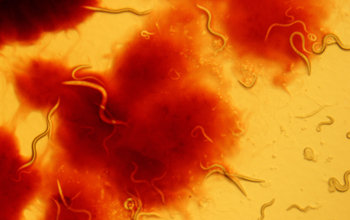Multimedia Gallery
Nematode Host Meets Bacterial Pathogen
This image shows the nematode host Caenorhbaditis elegans encountering the bacterial pathogen S. marcescens. Natural selection imposed by the co-evolving pathogen led to the evolution and maintenance of bi-parental sex in the host population.
The host and the pathogen were experimentally co-evolved to test the Red Queen hypothesis--that co-evolution with pathogens can select for the maintenance of cross fertilization. Results of research by biologists at Indiana University (IU) support the Red Queen hypothesis prediction as co-evoloving S. marcescens, selected for increased outcrossing in C. elegans.
The IU researchers found that, although sexual reproduction between two individuals is costly from an evolutionary perspective, it is favored over self-fertilization in the presence of co-evolving parasites. Sex allows parents to produce offspring that are more resistant to the parasites, while self-fertilization dooms populations to extinction at the hands of their biological enemies.
To learn more, see the IU news story Sex, as we know it, works thanks to ever-evolving host, parasite relationships, IU biologists find. [Research supported by National Science Foundation grant DEB 06-40639.] (Date of Image: June 2011)
Credit: Levi Morran, Indiana University
See other images like this on your iPhone or iPad download NSF Science Zone on the Apple App Store.
Images and other media in the National Science Foundation Multimedia Gallery are available for use in print and electronic material by NSF employees, members of the media, university staff, teachers and the general public. All media in the gallery are intended for personal, educational and nonprofit/non-commercial use only.
Images credited to the National Science Foundation, a federal agency, are in the public domain. The images were created by employees of the United States Government as part of their official duties or prepared by contractors as "works for hire" for NSF. You may freely use NSF-credited images and, at your discretion, credit NSF with a "Courtesy: National Science Foundation" notation.
Additional information about general usage can be found in Conditions.
Also Available:
Download the high-resolution JPG version of the image. (17.6 MB)
Use your mouse to right-click (Mac users may need to Ctrl-click) the link above and choose the option that will save the file or target to your computer.



